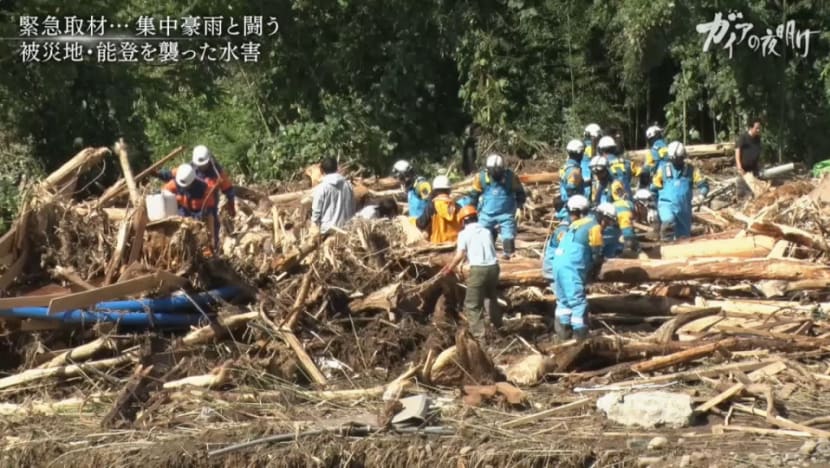Gaia Series 71: Fighting torrential rains! Extreme Weather (1)
Amid Japan's escalating floods, Wajima's resilience shines through human stories and innovations like Mr Waterstopper. From Sasaki's airboat to rebuilding efforts, this episode highlights the spirit and ingenuity to safeguard lives and livelihoods.


This audio is generated by an AI tool.
This week’s episode explores how resilience and innovation help Japan face growing environmental challenges.
In Japan’s Hokuriku region, the scars of recent natural disasters serve as a stark reminder of nature’s power and the resilience of those who endure it. Ishikawa Prefecture’s Wajima City, still reeling from the devastating Noto earthquake earlier this year, is hit by torrential rains that overwhelm the region. In just 24 hours, over 400 millimetres of rain fall, causing rivers to overflow and submerging parts of the city in a muddy torrent. “The river is overflowing due to the heaviest rain ever recorded,” observes the narrator as scenes of destruction unfold.
For the residents of Wajima, this flood is not just another disaster—it is a cruel sequel to an already devastating earthquake. Homes, businesses, and lives are thrown into disarray as the community grapples with the aftermath of what locals call a "double disaster." The destruction is palpable in the voices of those affected. One resident remarks, “It was like a river... we were immersed up to the waist.”
Amidst the wreckage stands Yuko Oomukai, a Wajima lacquerware artisan, who sifts through flood-damaged tools and inventory. Wajima lacquerware, a traditional craft emblematic of the region’s cultural heritage, lies soaked in water and coated with mud. Oomukai recalls how the New Year’s earthquake had already destroyed her workplace. “We used this place to store everything, but it was damaged by the water, so we are getting them out again,” she explains, frustration and determination blending in her voice.
The disaster has shaken not only businesses, but also the sense of stability among the residents. Shinsuke Gushima, a Shinkin bank worker and lifelong resident of Wajima, embodies the community’s determination to rebuild. Visiting flood-hit businesses daily, he listens to their stories and offers support wherever possible. For some, the challenges are overwhelming. One business owner confesses, “I thought I couldn’t take this anymore,” as he surveys the damage to his shop. Despite the hardship, Gushima is undeterred, seeing his role as integral to the recovery effort.
At the heart of the devastation is Takashi Mitsuji, who owns a packaging materials shop that has been severely impacted. As workers clear mud and debris from his warehouse, Mitsuji laments the losses. “The chunks of wood amount to around seven million yen (S$61,000),” he reveals. The financial strain is immense, but the sight of neighbours and volunteers rallying together to restore what can be saved underscores a community united in resilience.
In the wake of such disasters, innovative solutions emerge as a beacon of hope. Among these is Mr Waterstopper, a device designed to replace traditional sandbags in flood prevention. Invented by 45-year-old Shunichi Koyama and developed by Nagoya-based Inaki Rubbers, the water stopper effectively blocks water up to 30 centimetres high and is gaining traction across Japan. “The amount of leaked water is one-fortieth compared to sandbags,” explains Koyama. Scenes of its installation in factories, shops, and residential areas illustrate its practicality and effectiveness. “It’s quite light and flexible,” remarks one user, highlighting its adaptability for various settings.
While communities work to prevent future damage, others focus on immediate rescue efforts. Ko Sasaki, 67, a self-taught inventor, is one such individual. Sasaki’s mission began after losing a friend in the 2011 Tohoku earthquake and resulting tsunami. Driven by this loss, he developed airboats specifically designed for rescue operations which has since been adopted by the Tokyo Fire Department and the Rapid Response Unit. These boats proved their worth during the 2019 Typhoon Hagibis floods and were deployed again during the recent rains in Yamagata Prefecture.
However, the size and weight of Sasaki’s airboats weighing in at 1.3 tons, limit their use in mountainous areas. Recognising this, Sasaki begins developing a smaller, more portable airboat. His latest design, which is powered by an engine he calls Air Strider, weighs only 70 kilograms a significant reduction, making it easier to transport and deploy. “Floods will occur again, anywhere, right? I want this to be used by municipalities, one by one,” Sasaki shares, expressing his vision for a more prepared and responsive future.
The increasing frequency and severity of such natural disasters raise questions about preparedness and adaptation. Since 2013, flood-related damages across Japan have exceeded seven trillion yen, underscoring the urgent need for resilient infrastructure and innovative technologies. In Wajima, where over half the businesses remain closed, the challenges of recovery are immense, yet the spirit of its people remains unbroken.
Amid the devastation, there are moments of profound human connection and strength such as when Shinkin bank employees work tirelessly alongside Wajima residents, clearing debris and offering support. One resident expresses their appreciation: “They’re truly here for us. I can only feel gratitude.” These acts of solidarity remind us that even in the darkest times, the light of communal resilience shines through.












